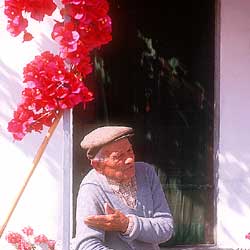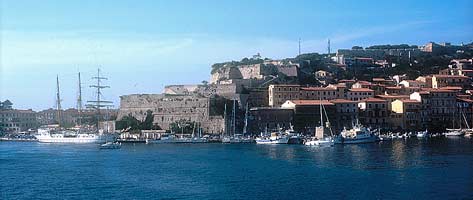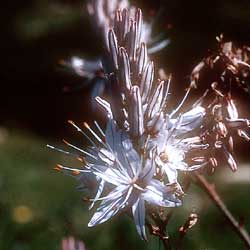 It is the biggest island of the extraordinary Tuscan archipelago, with
over one hundred kilometres of indented and variegated coastline, modelled
by the Libeccio and Maestrale winds, with unending inlets, small coves,
like niches set in the tormented rocks.
It is the biggest island of the extraordinary Tuscan archipelago, with
over one hundred kilometres of indented and variegated coastline, modelled
by the Libeccio and Maestrale winds, with unending inlets, small coves,
like niches set in the tormented rocks.
It is the island of the Etruscans, the Romans, the Medici, and Napoleon.
It is the island of minerals, perfumes and flowers. Between sea, mountains
and small villages it is, above all in the low season, a relaxing meander
always within sight of a spacious panorama.
It is a realm of water and sub-aqua sports which in the transparent
surrounding waters find one of the most suitable locations for this pursuit,
but it is also a realm of walks between sea and mountain ; an intelligent
meandering always in sight of marvellous panoramas emerging from the Tirreno
sea. This rock, as it is described by the "Elbani" (inhabitants
of Elba), being far away from the continent, until thirty years ago was
forgotten by everyone, the people survived thanks to the ever consistent
mineral riches beneath the ground.
The unexpected and tumultuous conversion of the economy, which had always
been based on the minerals industry, agriculture and fishing, now leans
almost exclusively towards tourism. All this brings unarguable benefits
to the population :Hotels, pensions, farm holidays, and campsites appear
but agricultural activities have been abandoned, the fields, vineyards
and allotments easy prey to the luxuriant undergrowth. They closed the
furnaces, they rested on their laurels they built too much too badly.
Today the three months of frenetic hard work enable them to forget the
never ending long days of the winter and spring. It is only in these periods
that the island finds itself again, and re-acquires its real intimacy
and genuine nature. It finds its real fascination again characterised
by a return to the olden ways as if "painted over" in order
to give it back to the inhabitants. Autumn and Spring are the best seasons
to visit the island, to get to know the more salient aspects, to appreciate
the sensibility and salty sincerity of its population. The Elban Olympus
and the Pomonte valley.
 When the Mistral blows bringing stable weather the sky becomes limpid
and the days are ideal to tackle the thousand metres high Capanne mountain
.
The enormous conical promontory certainly represents the most impervious
and wildest place in the whole island. Along its circumnavigation, which
more or less corresponds with its coastline, and goes from Procchio to
Marina di Campo, there is a continual line of villages and typical hamlets.
In the internal zone, along the steep precipices covered in low, dense
thorny undergrowth there is a complete absence of anthropic activity.
In order to climb to the top, unfortunately invaded by a forest of aerials,
there are various possibilities : the comfortable cable-car which leaves
from Marciana (enquire about the days and hours of departure) and several
pathways which cross the valleys, greenhouses and spurs, gently penetrating
the rocky and wild ambience of the Elban Olympus. The orography and the
dominant winds are the cause of the particular floral diversity which
is verified on the same vegetal horizon : chestnut and pine trees, undergrowth
of juniper, cysto and lentisk, manage to live together in the small space
of a few kilometres. The yellow thorny dwarf broom Salzmannii characterises
the topmost part of the ridge with its
cushion like bushes (the most beautiful are those near "Semaforo"
(Traffic-light) above Chiessi) which from the top lead down in rays to
the sea, while on the rocky sinuous recesses of the gullies and of Monte
Giove it is possible to admire, next to the heather, the stupendous lily
of S. Giovanni, protected flower typical of the Appenine mountains. As
well as the vegetal interest there is also a huge panoramic interest.
From the peak and its slopes the vastness of the horizon seems immense
and as the islands of Caraia, Pianosa and Montecrsto seem to be close
at hand, so do the mountains and cities of the further off Corsica.
 Among
the various and beautiful valleys which start from Monte Cappane we have
chosen those of Pomonte (at the foot of the mountain), Chiessi and Marciana.
The first two begin from the rocky magnificence of the mountain to finish
in the crystal clear waters of the Tirreno sea which at that place faces
the nearby Corsica ; the third descends directly from Monte Capanne. The
punchbowls, protected from the north winds, appear like climatic oasis
typical of the Mediterranean. Among
the various and beautiful valleys which start from Monte Cappane we have
chosen those of Pomonte (at the foot of the mountain), Chiessi and Marciana.
The first two begin from the rocky magnificence of the mountain to finish
in the crystal clear waters of the Tirreno sea which at that place faces
the nearby Corsica ; the third descends directly from Monte Capanne. The
punchbowls, protected from the north winds, appear like climatic oasis
typical of the Mediterranean.
The valleys should be visited in May to be seen in all their multicoloured
splendour. The blossoms of the Mediterranean undergrowth and the perfumes
of the strongest of the essences inebriates the rambler who occasions
to walk there always immersed in a dreamlike ambience, panoramic and interesting
under a naturalistic profile.
Leaving from the village of Pomonte you have means of appreciating a world
that is disappearing. The last of the old people still come out of their
little white houses to work daily in their allotments and vine yards carved,
with a lot of hard work, on the sides of the mountain and well irrigated
by the copious waters of the Bertone pothole. Along the two ancient well
paved and lately re-cleaned mule tracks (believed to be dated from the
Roman period), you can reach the Pass of S. Bartolomeo which takes you
to Chiessi, the same Capanne with its 1018 metres of crude rocks and finally
to the town of Marciana.
|